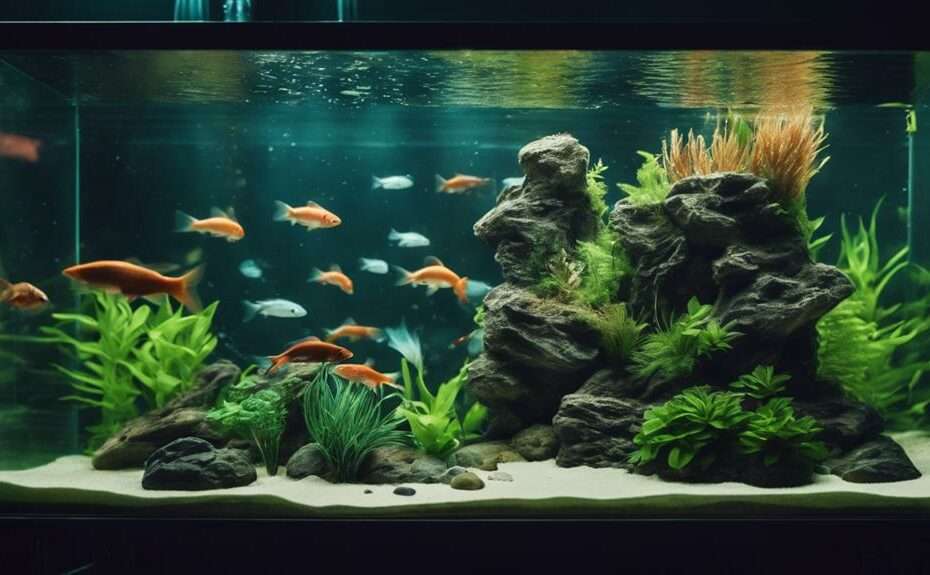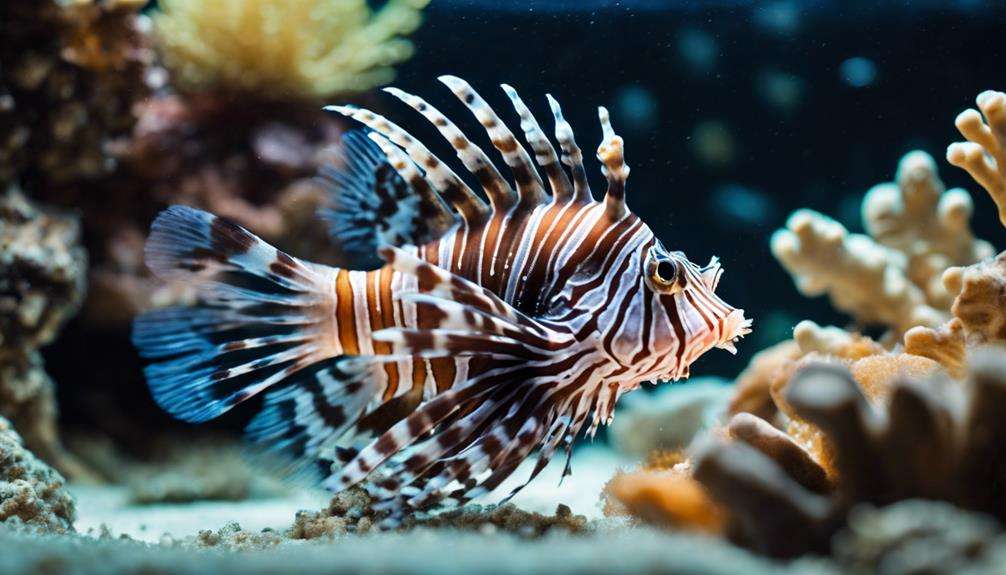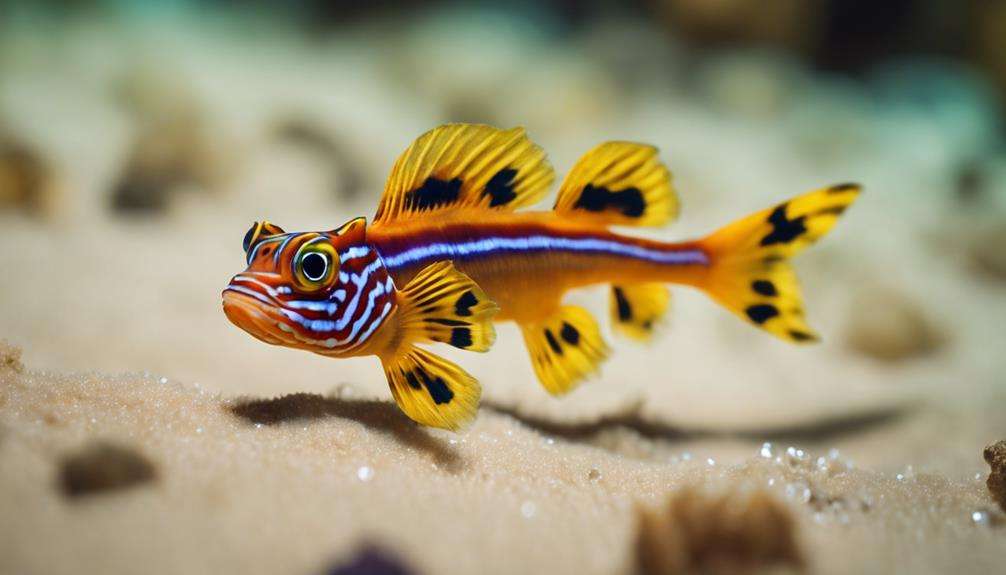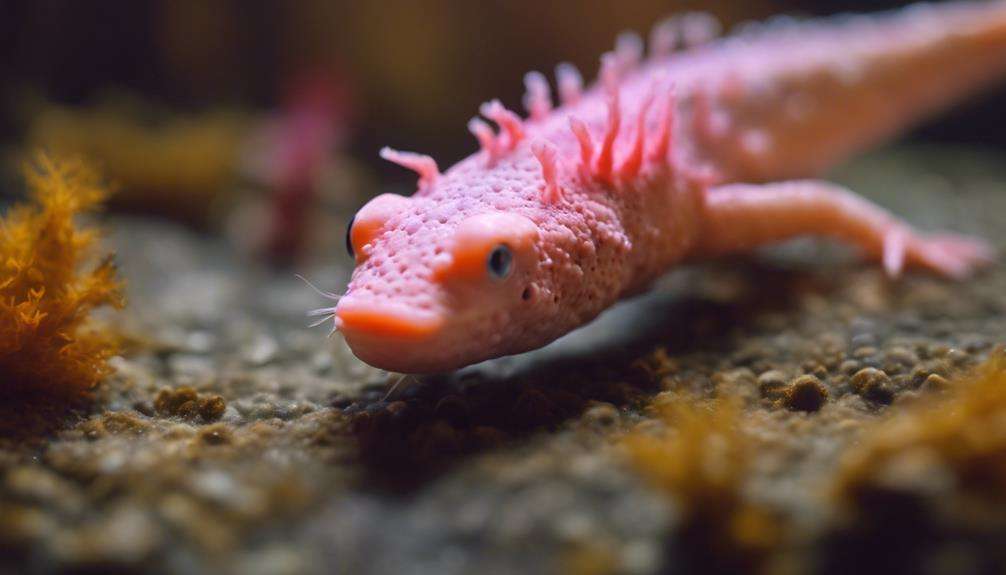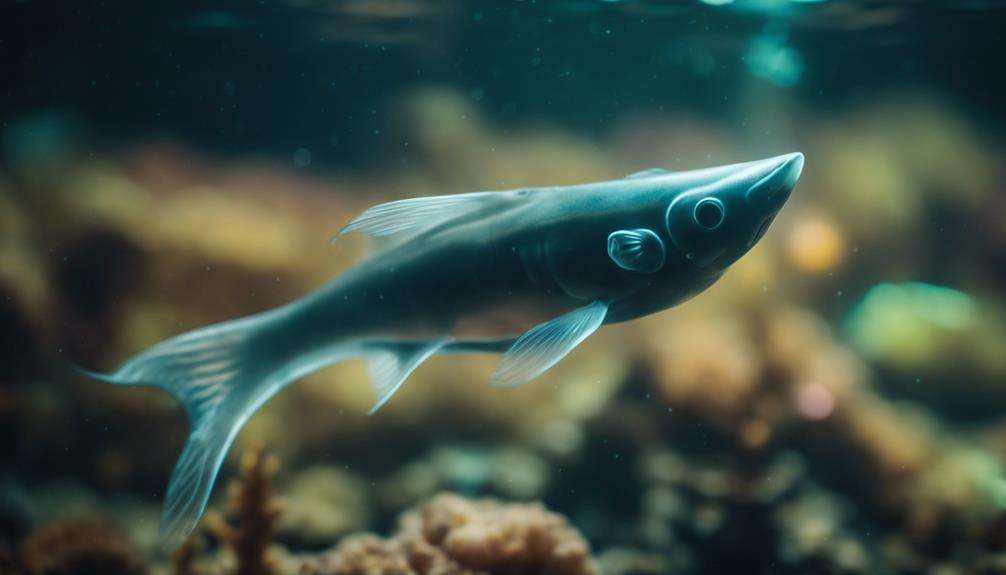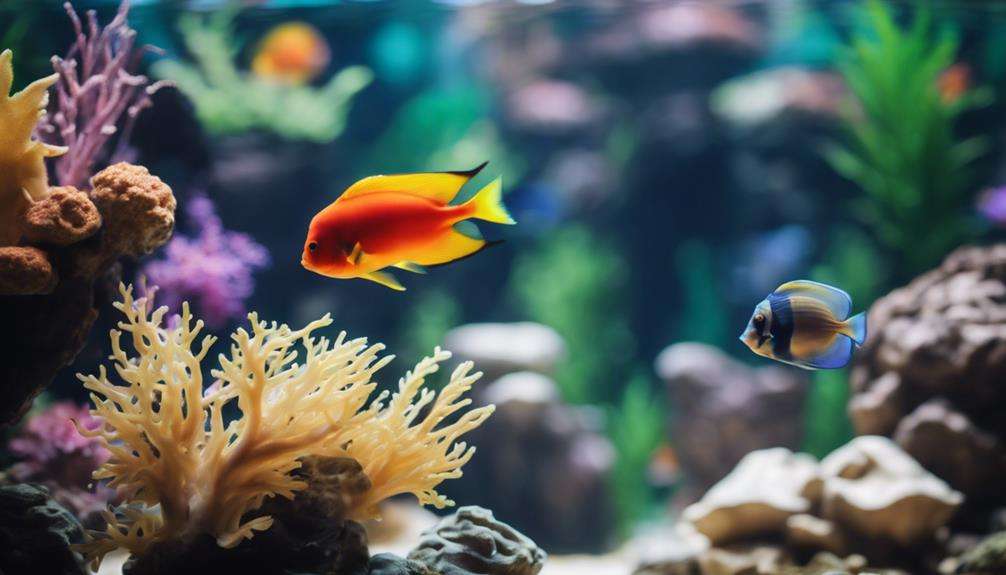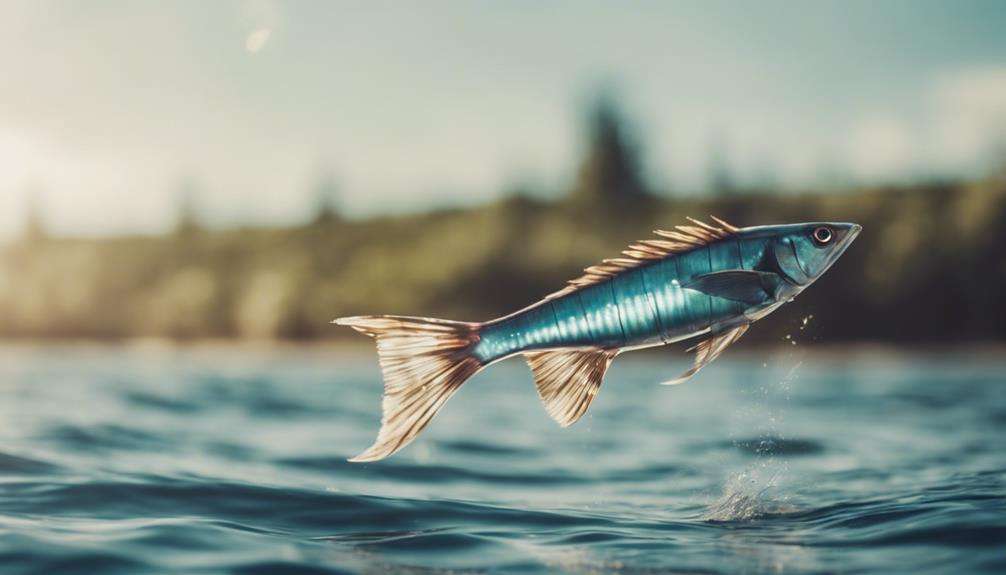When diving into the world of keeping predatory aquarium fish, remember that knowledge is your best ally. Understanding their hunting instincts and behaviors is just the beginning.
But what about the intricate dance of selecting suitable tank mates for these finned hunters? Stay tuned to discover the essential tips that will help you navigate the captivating yet challenging realm of caring for predatory fish in your aquarium.
Key Takeaways
- Choose tank mates with compatible behaviors and similar size for a harmonious environment.
- Monitor water quality closely, especially for predatory species sensitive to changes.
- Provide enrichment through habitat mimicry and behavioral stimulation for overall well-being.
- Handle aggression by establishing territories, monitoring interactions, and considering individual fish personalities.
Understanding Predatory Fish Behavior
Predatory fish exhibit distinct hunting or ambush behaviors, making it crucial to understand their predatory nature when choosing tankmates. When selecting companions for predatory fish, it's essential to consider the size of the potential tankmates. Smaller fish are particularly at risk of becoming prey to larger predatory species. Therefore, it's advisable to avoid pairing small fish with larger, more aggressive predators to prevent unnecessary stress or harm to the tank's inhabitants.
For a harmonious aquatic environment, choose tankmates that are of similar size and have compatible behaviors with predatory fish. By opting for suitable companions, you can reduce the likelihood of aggressive interactions and create a balanced ecosystem within your aquarium. Additionally, observing the hunting patterns and preferred prey of your predatory fish can offer valuable insights into their behavior, aiding in the selection of appropriate tankmates. Remember, a well-thought-out selection of tankmates enhances the overall well-being of your predatory fish and fosters a thriving aquatic community.
Suitable Tank Size and Setup
To provide optimal care for predatory fish, selecting an appropriately sized tank and arranging a suitable aquatic environment is essential. Predatory fish species vary in their tank size requirements, with larger species needing spacious tanks to accommodate their size and swimming habits.
For small predatory fish, a minimum tank size of 120 cm x 45 cm x 45 cm is recommended as a starting point to ensure they've enough room to move comfortably. It's crucial to maintain good water quality in the tank to support the health and well-being of these fish.
When setting up the tank, include hiding spots like caves, dense planting, and minimal decor to replicate their natural habitat and cater to their hunting instincts. Larger predatory fish may require extra space for territorial behavior, while smaller species can thrive in appropriately sized tanks with suitable hiding places.
Selecting Compatible Tank Mates
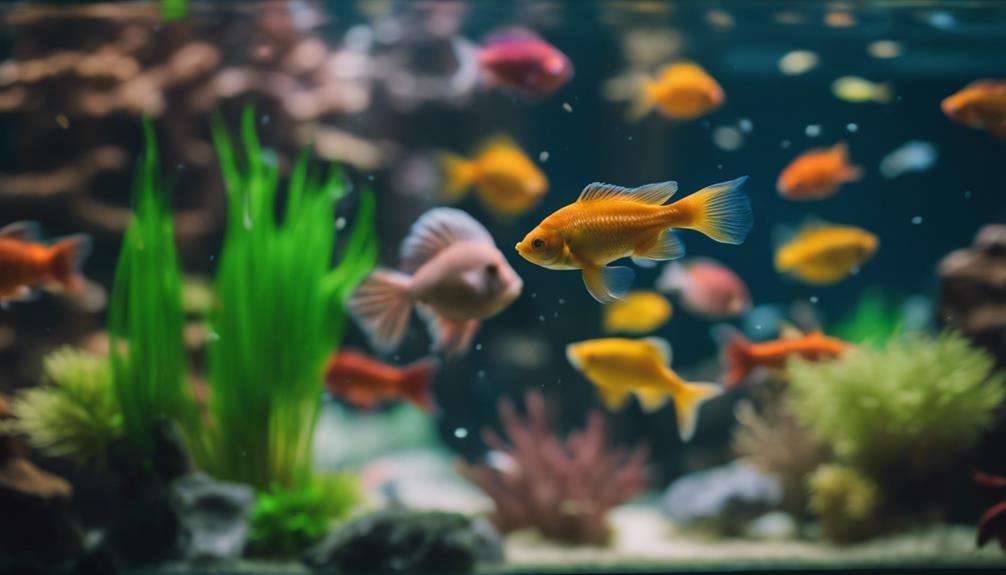
When selecting tank mates for your predatory fish, it's crucial to consider factors like size compatibility to prevent aggression.
Observing the behavior of potential tank mates closely is important to ensure a harmonious aquatic environment.
Remember to conduct thorough research before adding any new fish to your tank to promote a peaceful coexistence among the different species.
Fish Compatibility Factors
Consider the compatibility of tank mates for your predatory aquarium fish by assessing their size, behavior, and defensive capabilities to minimize potential conflicts and ensure a harmonious environment. When selecting compatible tank mates for predators, keep in mind the following factors:
- Size Matters: Ensure that potential tank mates aren't too small to be seen as prey by the predatory fish.
- Behavior Analysis: Research the behavior and temperament of both the predator and potential tank mates before introducing them.
- Speed and Defense: Opt for fast-swimming species or those with defensive mechanisms to avoid becoming targets.
- Avoid Aggressive Species: Steer clear of pairing predators with aggressive or territorial fish to prevent conflicts.
- Gradual Introduction: Introduce new tank mates slowly to observe interactions and ensure compatibility with the predatory fish.
Behavioral Observations Important
Observing the behavior of predatory fish plays a crucial role in selecting compatible tank mates to maintain a harmonious aquarium environment free from aggression. When choosing tank mates for aggressive fish, it's essential to consider the size of the potential companions. Smaller fish are often at risk of being attacked or eaten by larger, predatory species.
Look for fish that exhibit similar activity levels and feeding habits to decrease the likelihood of conflicts. Understanding the natural behaviors and habitats of different species can help create a balanced ecosystem within the tank. Avoid pairing aggressive fish with timid or slow-moving species that may become targets for aggression or predation.
Regularly monitoring interactions and making adjustments as needed can help ensure a peaceful coexistence among the fish in your aquarium.
Research Before Adding
To ensure a successful and harmonious aquarium environment for predatory fish, thorough research on the behaviors and compatibility of potential tank mates is essential. When selecting compatible tank mates for your predatory fish species, consider the following:
- Research Fish Species: Understand the specific behaviors and requirements of both the predatory fish and potential tank mates.
- Tank Size Requirements: Ensure the tank size is adequate to accommodate the predatory fish and their tank mates comfortably.
- Compatibility: Choose tank mates that aren't seen as prey, can coexist peacefully, and have similar water parameter needs.
- Aggression Level: Avoid pairing aggressive fish with timid species to prevent stress or harm.
- Feeding Habits: Select tank mates with compatible feeding habits to avoid competition and ensure all fish are adequately nourished.
Feeding Strategies for Predatory Fish
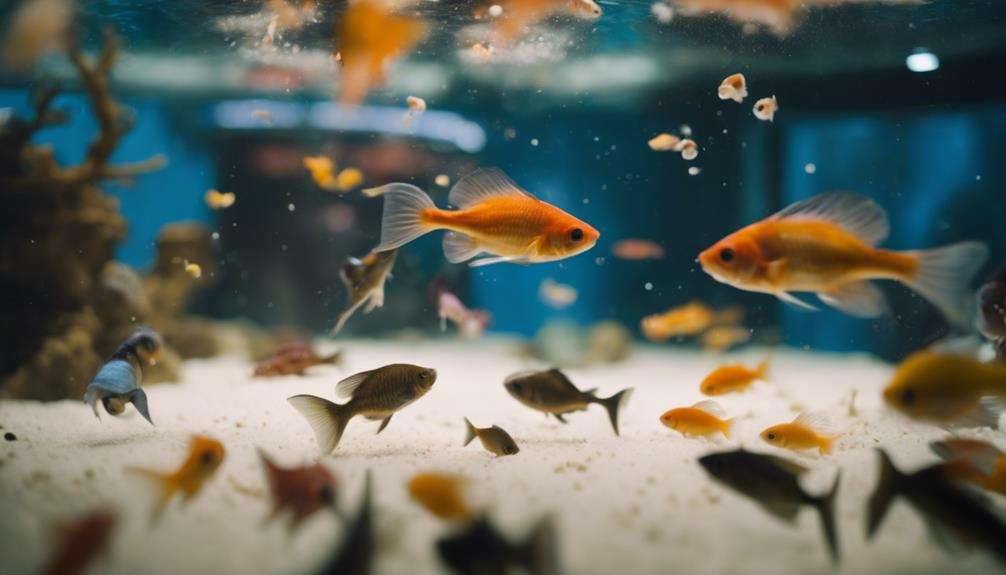
For predatory fish to thrive, a high-protein diet comprising a variety of live foods such as invertebrates, insects, and frozen lancefish is essential. Live foods offer enrichment and mimic natural hunting behaviors, promoting the overall well-being of predatory fish. However, caution must be exercised when using feeder fish like goldfish and rosy-red minnows due to their high fat content and thiaminase levels, which can lead to health issues and premature death in predatory fish.
Safer alternatives for feeder fish include livebearers such as mosquitofish and mollies, which provide a more balanced nutritional profile. Thiaminase present in some feeder fish can break down essential vitamins in predatory fish, underscoring the importance of a diverse diet to prevent nutritional deficiencies.
When weaning predatory fish onto non-living foods, a gradual transition is crucial to ensure they receive adequate nutrition for optimal health and growth. By offering a balanced diet that avoids relying solely on feeder fish, you can help your predatory fish thrive in captivity.
Providing Enrichment and Hiding Spots
To ensure the well-being of your predatory aquarium fish, it's essential to provide enrichment options that mimic their natural environment.
Hiding spots such as caves, plants, and driftwood are crucial for creating a sense of security and reducing stress levels in your fish.
Enrichment Options
Enhancing the environment of your predatory aquarium fish with hiding spots and enrichment options encourages natural behaviors and mental stimulation. Providing enrichment options like PVC pipes, rocks, and tunnels offers opportunities for exploration and mental stimulation.
Creating a diverse tank layout with open spaces and vegetation encourages natural behaviors in predatory fish. Rotating and changing decor periodically prevents boredom and promotes active engagement in predatory fish.
Offering live food challenges predatory fish mentally and physically, stimulating hunting instincts and reducing aggression.
Hiding Spot Essentials
Incorporate caves, dense vegetation, and structures into your predatory aquarium setup to provide essential hiding spots mimicking their natural habitat. Predatory fish, such as those that feed on live fish, benefit from these hiding spots as they reduce stress and promote natural behaviors like hunting and resting.
For community fish in a planted aquarium, hiding spots help establish territories, reducing aggression and conflicts. Ensure a variety of hiding spots at different levels in the tank to accommodate swimming preferences.
Enriching the environment with these hiding spots encourages exploration, reduces boredom, and promotes the overall well-being of your predatory fish. By creating a habitat that mirrors their natural environment, you can help your predatory fish feel secure and thrive in your aquarium.
Behavioral Stimulation Techniques
Introducing floating toys or objects that mimic prey movement can effectively stimulate the predatory instincts of aquarium fish, enhancing their behavioral enrichment. To keep your predatory fish engaged and mentally stimulated, consider the following techniques:
- Live Food: Incorporate live food into their diet to provide a more natural hunting experience.
- Feeding Challenges: Use feeding puzzles or slow-release feeders to make mealtime more engaging.
- Hiding Spots: Create hiding spots with caves, plants, and driftwood to give your fish a sense of security.
- Variety in Tank Decor: Include diverse textures and structures in your aquarium to encourage exploration and natural behaviors.
- Time-Based Feeding: Establish a feeding schedule that mimics natural hunting patterns to maintain your fish's behavioral health.
Monitoring Water Quality and Parameters
Regularly testing water parameters such as pH, ammonia, nitrite, and nitrate levels is crucial to ensure a healthy environment for your predatory aquarium fish. Predatory species are particularly sensitive to water quality, so maintaining optimal conditions is essential for their well-being.
Live predatory fish require specific water conditions to thrive, and any fluctuations in parameters can stress or even harm them. It's important to keep the water clean and clear, as predators are highly susceptible to changes in their environment.
Additionally, monitoring oxygen levels in the water is vital for supporting the respiratory needs of predatory fish, especially in densely stocked tanks. Understanding the specific water quality requirements of your predatory species is key to providing them with a suitable habitat.
Make necessary adjustments to filtration systems and maintenance practices to meet the unique needs of your predators and ensure they live in a healthy aquatic environment.
Handling Aggression in Predatory Species
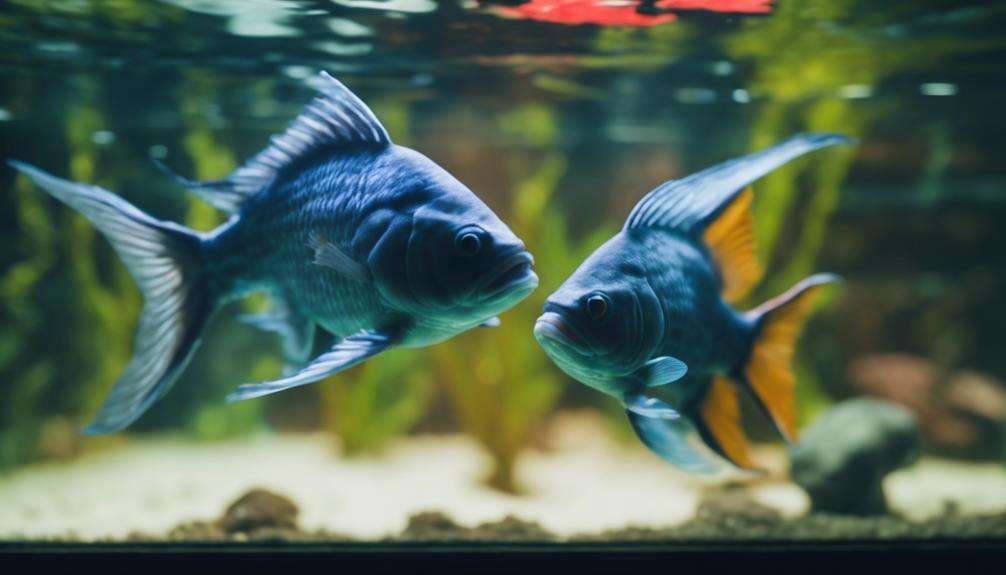
To manage aggression in predatory species effectively, observe and interpret behavioral cues indicating potential conflict within the aquarium environment. Predatory fish can exhibit signs of aggression such as fin nipping, chasing, or displaying territorial behavior. By recognizing these behaviors early on, you can take steps to address and minimize aggression within your aquarium.
Here are some key strategies to handle aggression in predatory species:
- Provide ample hiding spots and territories within the tank to reduce aggression and establish boundaries.
- Monitor tank dynamics closely to identify any conflicts or aggression early on and take appropriate action.
- Avoid overcrowding the tank to minimize stress and competition, which can lead to aggressive behavior.
- Implement a feeding schedule that ensures all fish receive adequate nutrition without triggering aggressive feeding behaviors.
- Consider the individual personalities of the predatory fish species you're keeping and adjust their environment accordingly to prevent conflicts.
Health and Disease Management for Predatory Fish
To maintain the well-being of your predatory fish in an aquarium setting, proactive health and disease management practices are crucial. Predatory fish such as South American leaf fish and Spiny eels are susceptible to common aquarium diseases like ich, fin rot, and bacterial infections.
One key strategy to prevent the spread of diseases is to quarantine new fish before introducing them to the main tank. Monitoring water parameters regularly is essential to catch any fluctuations that can stress predatory fish, making them more vulnerable to illnesses.
Prompt treatment of diseases with appropriate medications is vital to prevent them from spreading throughout the tank. Additionally, providing a stress-free environment with a proper diet, clean water, and suitable tank conditions can help boost the immune systems of predatory fish, making them more resilient against potential health issues.
Frequently Asked Questions
How Do You Keep Predatory Fish?
To keep predatory fish, maintain suitable tank setup with ample space, quality filtration, and appropriate decor. Cater to their feeding habits with tailored diets. Observe behavior patterns for signs of stress or aggression. Regular water changes are crucial.
What Is the Most Aggressive Fish for an Aquarium?
When it comes to aggressive aquarium fish, the Red-Bellied Piranha takes the crown. With razor-sharp teeth, group hunting tactics, and a taste for flesh, this South American native demands a large tank, careful tank mate selection, and regular feeding.
How Do You Take Care of an Aggressive Fish?
When caring for an aggressive fish, focus on feeding habits by offering a varied diet, setting up the tank with hiding spots, and monitoring behaviors closely. Manage aggression triggers and establish a routine to promote harmony.
What Is the Hardest Fish to Keep in an Aquarium?
Keeping the freshwater stingray in an aquarium can be challenging due to its large size, specialized care needs, and venomous spines. They require a spacious tank, soft substrate, careful tankmate selection, and a varied diet for optimal health.
Conclusion
In conclusion, when keeping predatory aquarium fish, it's crucial to provide a suitable environment that meets their behavioral and dietary needs.
Did you know that some predatory fish species have been known to live up to 15 years in captivity when properly cared for?
By following the top tips outlined in this article, you can ensure a healthy and thriving aquarium for your predatory fish.
Remember, research and preparation are key to success in keeping these fascinating creatures.
